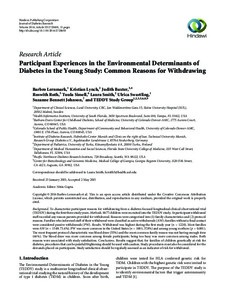Participant Experiences in the Environmental Determinants of Diabetes in the Young Study: Common Reasons for Withdrawing
Roth R; Baxter J; Simell T; Johnson SB; and Teddy Study Group; Smith L; Lynch K; Lernmark B; Swartling U
https://urn.fi/URN:NBN:fi-fe2021042716153
Tiivistelmä
BACKGROUND:
To characterize participant reasons for withdrawing from a diabetes focused longitudinal clinical observational trial (TEDDY) during the first three study years.
METHODS:
8677 children were recruited into the TEDDY study. At participant withdrawal staff recorded any reason parents provided for withdrawal. Reasons were categorized into (1) family characteristics and (2) protocol reasons. Families who informed staff of their withdrawal were classified as active withdrawals (AW); families without a final contact were considered passive withdrawals (PW).
RESULTS:
Withdrawal was highest during the first study year (n = 1220). Most families were AW (n = 1549; 73.4%). PW was more common in the United States (n = 1001; 37.8%) and among young mothers (p = 0.001). The most frequent protocol characteristic was blood draw (55%) and the most common family reason was not having enough time (66%). The blood draw was more common among female participants; being too busy was more common among males. Both reasons were associated with study satisfaction.
CONCLUSIONS:
Results suggest that, for families of children genetically at risk for diabetes, procedures that can be painful/frightening should be used with caution. Study procedures must also be considered for the demands placed on participants. Study satisfaction should be regularly assessed as an indicator of risk for withdrawal.
Kokoelmat
- Rinnakkaistallenteet [19207]
